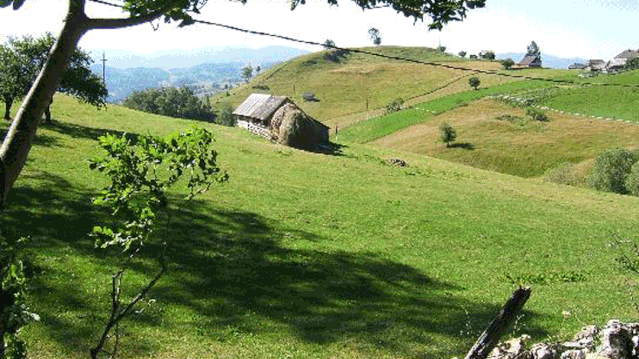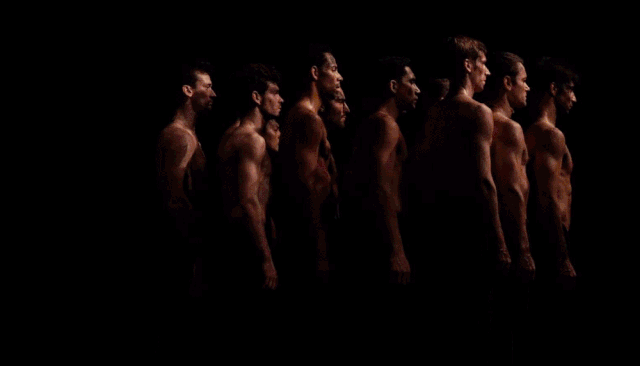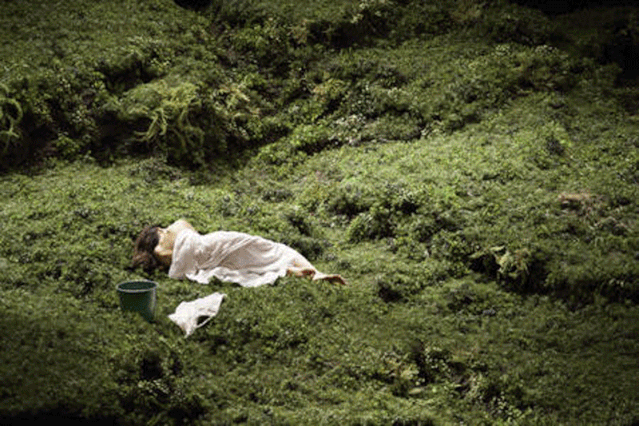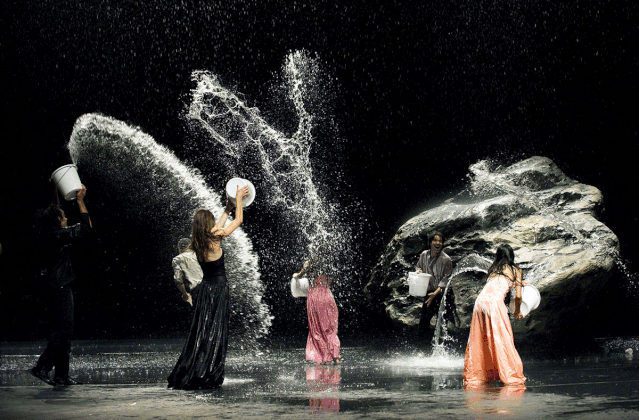设计师带你读懂当代戏剧:Wiesenland
Contemporary drama: Wiesenland
Wiesenland 指的是meadowlands,即草原之地。它的创作受到了Pina Bausch 在2000年对匈牙利首都-布达佩斯和周边乡村为期17天的游历的启发。同时也受到了当地民间习俗、还有关于无垠的Transylvanian边境地形的启发。
Wiesenland, meaning meadowlands, the land of meadows, was apparently inspired by a seventeen-day visit in 2000 to Hungary, its capital, and surrounding countryside, by its folklore, by the endless Transylvanian borderlands terrain.
01
设计师的看剧笔记
Designer's Note
02
《草原国度》之灵感来源:
匈牙利草原风光 & 布达佩斯温泉文化
最早关于 Transylvania 的记载出现在1075年匈牙利王国的中世纪拉丁语的文档中,名为ultra silvam,意为“森林之外”(ultra意为“超越”或“在森林的另一边”)。在历史记载中 Transylvania 的核心地区大致相当于现在罗马尼亚的九个县大小。高原几乎完全被喀尔巴阡山脉的东部、南部和罗马尼亚西部的分支所包围。该地区包括 Transylvania 平原。
The earliest known reference to Transylvania appears in a Medieval Latin document of the Kingdom of Hungary in 1075 as ultra silvam, meaning "beyond the forest" (ultra meaning "beyond" or "on the far side of" ). This core of historical Transylvania roughly corresponds with nine counties of modern Romania. The plateau is almost entirely surrounded by the Eastern, Southern and Romanian Western branches of the Carpathian Mountains. The area includes the Transylvanian Plain.
布达佩斯是一个拥有多温泉、土耳其浴场和温泉浴场的城市,与多瑙河接壤。布达佩斯市内有许多温泉浴,有的是露天的,有的是室內的。这是他们的社交场所,下棋、谈心、看书、睡觉,一切都可以在这里进行,有些温泉浴里形成了它们自己的亚文化。
Budapest is a city – two cities bordering the Danube – of hot springs, Turkish baths and spas. There are many hot springs in Budapest, some are outdoor and some are indoor. It's a social place for them, playing chess, talking, reading, sleeping, everything can be done here. Some hot spring baths have formed their own subculture.
03
关于《草原国度》
About Wiesenland
03-1 导演和编舞: 皮娜·鲍什
Direction and Choreography: Pina Bausch
皮娜·鲍什(Pina Bausch),1940年出生于Solingen,2009年在Wuppertal去世。她在Essen的Folkwang学校接受了Kurt Jooss的舞蹈训练,在这段时间中她习得了卓越的舞技。在Wuppertal剧院的导演阿诺·伍斯坦霍弗(Arno Wustenhofer)聘请她担任舞蹈指导后不久,她从1973年秋季开始将剧团更名为伍珀塔尔坦茨剧院(Tanztheater Wuppertal)。剧院的更名虽然一开始就引起争议,但逐渐获得了国际认可。它的诗性元素与日常元素的结合,对舞蹈的国际发展产生了决定性的影响。Pina Bausch被授予一些全球性最伟大的奖项和荣誉,是当今最重要的编舞家之一。
Pina Bausch was born 1940 in Solingen and died 2009 in Wuppertal. She received her dance training at the Folkwang School in Essen under Kurt Jooss, where she achieved technical excellence. Soon after the director of Wuppertal's theatres, Arno Wüstenhöfer, engaged her as choreographer, from autumn 1973, she renamed the ensemble the Tanztheater Wuppertal. Under this name, although controversial at the beginning, the company gradually achieved international recognition. Its combination of poetic and everyday elements influenced the international development of dance decisively. Awarded some of the greatest prizes and honours world-wide, Pina Bausch is one of the most significant choreographers of our time.





03-2 舞台设计
Set Design
创造性的空间充满诗意,外部空间经常被引入舞台,将舞台扩展成景观呈现出来。这些空间是物理的,影响着舞者的动作。
The spaces created are poetic, with the outside often brought in, the stage expanded into a landscape. And the spaces are physical, affecting the dancers' movements.
Peter Pabst 令人惊叹的舞台布景设计包括一大片非常潮湿的青翠植被。我们先从垂直的方向看到它,它构成了舞台背景的悬崖立面,然后通过一些巧妙的水力装置,在水平方向形成了起伏的草地。
Peter Pabst’s amazing set includes a large and very wet tract of verdant vegetation, which we first encounter vertically, forming the façade of a cliff at the back of the stage and then, through some nifty hydraulics, horizontally, as an undulating meadow.

在Wiesenland舞台上,有一些疯狂而美妙的场景。包括刚组装就被拆卸的道具: 装有活鸡的鸡笼、摇摇欲坠的椅子塔、一个正式的餐厅布置里摆放着一些非正式的布置,如小炉子上的一盘炒菜、家具、枕头、毛巾。如果要有一个主题的话,那么在想象力、浪漫和感官享受的丰富性下,营造了一个比平常生活少些惆怅的氛围。
There were mad, wonderful vignettes in Wiesenland, involving props no sooner assembled than dismantled: the coop for live chickens, a precarious tower of chairs, a formal restaurant set-up, an informal stri-fry on a tiny stove, slapstick with furniture, pillows, towels. If there was a theme, maybe it was fecundity – of imagination, romance and sensuality, in an atmosphere less melancholy than usual.

03-3 水与身体
Costume Design
雨水可以让人透过衣服看到身体;大地使每一个动作塑造成力量的壮举;层叠的落叶描绘出舞者的舞步。
Water and rain allow the body to be seen through the clothes; earth makes every movement a feat of strength; the dancers' steps are traced in a layer of fallen leaves.

水在 Bausch 的作品中扮演着重要的角色,是一种象征元素,也因为口渴的舞者在排练时可以轻易地将水装在塑料瓶中随身携带。正如我们所知道的那样,水对于生命和纯净至关重要,但过多的水却令人不愉快,并带来威胁。
Water plays a significant role in most Bausch pieces, as a symbolic element or because it was readily to hand in rehearsals, carried around by thirsty dancers in plastic bottles. Vital for life and purity, water is unpleasant and threatening in excess, as we know this summer.
除了水源源不断的水流外,还有倾盆大雨,尤其是在开头部分,情节的多重层次感尤为强烈。舞者在水中沐浴,用毛巾擦拭自己的身体和地板。
Alongside the steady flow of water, there is also a downpour of imagery, particularly in the opening part, where the multi-layering of episodes is particularly intense. Dancers bathed in the water and mopped themselves and the floor with towels.
影片结尾反复出现的一幕是,女人们在吞云吐雾,而男人们则将一桶桶的水浇在女人们身上,这些女人们吸了一口烟,然后把头伸进了“瀑布”。这是否与布达佩斯热水浴冒出的蒸汽有关,或者只是一个日常行为的洗头?
A recurring scene at the end of the film, of women puffing on cigarettes while being doused by the men with buckets of water referred to steam rising and the women take a drag from the cigarette and then thrust their heads into the “waterfall”. Whether it's the steam from a Budapest hot bath, or just a ritual shampoo?
Credits:
导演和编舞 / Direction and Choreography:
Pina Bausch
舞台设计 / Set Design:
Peter Pabst
音乐 / Musical Collaboration:
Matthias Burkert
Andreas
Eisenschneider
服装/Costumes:
Marion Cito
联合演出 /Collaboration:
Marion Cito
Irene Martinez-Rios
Jan Minarik (Jean Mindo)
Robert Sturm
演出时长 / Duration:
2h 25min, one intermission
关于设计师
About the Designer

廖青
莫方 Eating Lab+Gallery+Theater 主理人
荷兰皇家艺术学院室内建筑专业(Interior Architecture) 研究生
清华大学美术学院环境艺术设计系室内设计专业 本科

